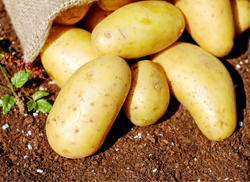
Persistent seed shortage has continued to affect potato production. It is for this reason that the Agricultural Development Corporation is developing new methods to grow potatoes in the country. The corporation has strategically narrowed down to focus on its strength and available opportunities, under the ADC Seed Potato Complex that comprises of two farms, a grading and cold storage facility and more recently a full functional tissue culture Lab and green house.
Led by CEO William Kirwa, the corporation has once again undertaken a research project, in collaboration with the CIP- International Potato Centre led by Dr. Ian Barker, to produce seed potato tubers in air, by means of a modern system known as aeroponics.
The aeroponic system of cultivation for the production of first generation seed potatoes is carried out in greenhouses and basically consists of maintaining the roots of the plant in the air and in conditions of total darkness, whereby nutrient-enriched water is sprayed on them periodically.
Roots grow in the air, and this enables a great exposure to air and avoids the contact of the tubers with soil pathogens. Therefore, the production per plant increases considerably. This increase brings the price of the tuber down substantially.
Today, iHub has more than 10,500 members, who include developers, designers, researchers, investors and mentors. Many of the members have spent time at the centre at one point or another — to fine-tune an app, pitch an idea to venture capitalists or simply meet peers to compare notes.
The system increases productivity, as it is expected that up to 50 tubers per plant can be obtained instead of the three or four achieved using conventional methods. Moreover, it reduces the rate of soil-based diseases such as PLRV; Bacterial wilts and it is a more sustainable system as it needs lower inputs of water and fertilisers in precise amount of both items needed by the plant at each phase of its development.
Most agricultural plants need a direct exposure to the sun during the first vegetative development. Afterwards this direct exposure is no longer relevant.
But the aeroponic system ensures a non-stop production cycle. Plant nutrition is supplied into a closed circuit. Consumption is consequently limited to only the quantities absorbed by the plants, allowing for substantial water savings. Because the aeroponic system is a continuous-cycle in an enclosed space it reduces the agricultural labour into a series of mechanical routine operational tasks which are carried out daily and throughout the year.
The aeroponic equipment is sheltered within greenhouses hence climate controls within the greenhouse ensure optimal growing conditions, assuring high yields. The basic local requirements to achieve this are some sunshine, a level area of land which is not shaded by mountains or high buildings.
The area should be accessible by road and have water of suitable quality for agricultural use and lastly a constant but small amount of electric power. Aeroponic growing is considered to be safe and ecologically friendly for producing natural, healthy plants and crops. The main ecological advantages of aeroponics are the conservation of water and energy.
As aeroponics is conducted in air combined with micro-droplets of water, almost any plant can grow to maturity in air with a plentiful supply of oxygen, water and nutrients and since the aeroponic systems because the increased aeration of nutrient solution delivers more oxygen to plant roots, stimulating growth and helping to prevent pathogen formation. Following increased growing of potatoes in Kenya, a technology has been developed to ease farmers’ access to markets. Mr Stephen Kimiri is the brain behind SokoShambani, an app that links potato farmers in Narok with buyers in Nairobi through Twitter.
The young techie formed a closed user group named @ViaziNarok through which farmers meet via mobile phones to share market reports and haggle with café managers in real time. SokoShambani creates a virtual distribution network that bypasses brokers and other middlemen, who exploit the traditional value chain to offer farmers up to a third of the real market prices. The idea of SokoShambani was conceived and developed at iHub in 2011. The app came to life through a series of workshops held at iHub dubbed Wireless Wednesday, a weekly meet up where those in attendance discussed mobile innovations in the field of griculture. Two years after he developed it, Kimiri’s app has won financial backing from American development agency, USAid Kenya, and technical support from the Dutch embassy in Nairobi. So far, more than 2,000 potato farmers from Narok and 17 hotels in Nairobi are “following” the agri-tweeting venture, which has been virtually bridging the 142-kilometre divide between producers and consumers.
The app has seen some farmers triple their earnings. iHub, an ideas factory that seeks to churn out apps that solve everyday problems facing Kenyans, opened its doors to techies like Kimiri in the first week of March 2010. It was modelled as an open working space for tech enthusiasts, who needed space to experiment, create and test apps for mobile platforms.
Several years after it was founded, the “ideas factory” on the fourth floor of Bishop Magua Centre on Nairobi’s Ngong Road has inspired developers to come up with apps that help farmers access market information, link patients to doctors through mobile platforms and ease processing of payments for small businesses.
Some have also made educational materials available on mobile devices. Today, iHub has more than 10,500 members, who include developers, designers, researchers, investors and mentors. Many of the members have spent time at the centre at one point or another — to fine-tune an app, pitch an idea to venture capitalists or simply meet peers to compare notes. The result is a win-win situation: Techies get an opportunity to test apps that solve social and economic challenges, while entrepreneurs get tools to grow their business ventures.
